What is Bonsai Deadwood
What is bonsai deadwood?
Bonsai deadwood: the definition

Deadwood on Japanese white pine bonsai
Bonsai deadwood refers to a part of a branch or trunk of a bonsai tree that has withered and turned into a skeleton-like wood.
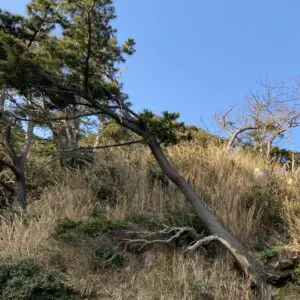
Deadwood on a pine tree in nature. The lower part of the trunk and branches became deadwood.
This phenomenon of deadwood on trees happens naturally in the wild due to strong winds or lightning strikes, causing parts of the branches or trunk to wither and become bone-like. Bonsai deadwood is a mere copy of this natural phenomenon to the bonsai trees.
Bonsai deadwood and its Zen influence
In bonsai, the contrast between the white, weathered parts of the trunk or branches and the remaining living wood is seen as a representation of the coexistence of life and death.
This symbolism comes from Zen Buddhism. Life and death in Zen religion are viewed indifferently; one and the same, so to speak. The practice of using deadwood in bonsai is a way to let go of a simple dualism of life and death and honor the resilience of trees that survive in harsh natural environments.
For more about the Zen influence on bonsai, the following post may be helpful.
Bonsai Deadwood vs. Jin, Shari and Uro
Bonsai deadwood generally refers to any area of dead wood on a bonsai tree, regardless of where we find them or how it got there. It can be on branches or trunks or created naturally or through intentional pruning or carving.
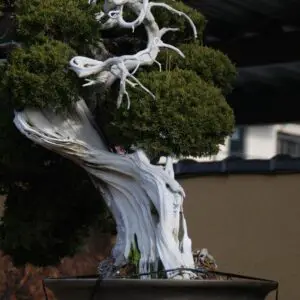
Shari (deadwood on trunk) and Jin (deadwood on branch)
Jin and Shari, on the other hand, are deadwood as well but more specific.
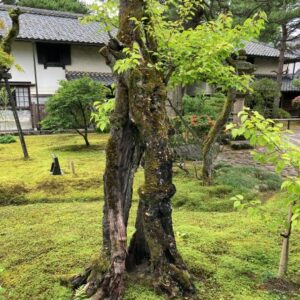
Uro (hollow) on a plum tree

Uro (hollow) on plum bonsai
In the world of bonsai, the decayed parts of trees at the tips of the branches are called “jin,” while those on the trunk are known as “shari”. If a scar on the trunk rotted and made large holes or cavities, it is called “Uro”.
The term “jin” refers to “gods” while “shari” refers to the remains of the Buddha’s bones in Japanese; both of which represent the spiritual nature of bonsai.
Purpose of the Bonsai Deadwood
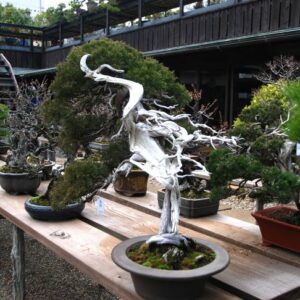
Japanese Shimpaku juniper (masterpiece)
The bonsai deadwood technique has both aesthetic and practical purposes.
Aesthetic purposes of bonsai deadwood
On the aesthetic side, deadwood is used to create a sense of age. The patterns and textures created by the deadwood can evoke a sense of ruggedness and resilience, making an impression that the tree stood in the ground for hundreds of years.
It can also serve as a representation of death and rebirth, a symbolism influenced by Zen Buddhism. The deadwood on a living bonsai tree, portrayed in the white and weathered branches contrasted with the remaining live wood, symbolizes the coexistence of life and death in every aspect of our lives.
Practical purposes of bonsai deadwood
Practically speaking, bonsai deadwood can serve a number of important functions. For one, it can help a tree to be more visually interesting. Living and dead parts in one tree can evoke mystery and fire viewers’ curiosity.
Also, deadwood can be used to hide scars or blemishes on the tree or to make use of dead branches or parts of the tree for creating a desired style.
Removing Dead Branches from Bonsai Trees
Dead branches on bonsai trees should be cut off if the problem is caused by pests and infestations. You can keep dead branches if the cause is environmental stress so long as you treat the cause.
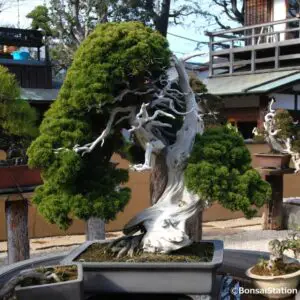
100 million yen Japanese juniper bonsai with interesting deadwood
This may sound surprising but dead branches are a common occurrence for bonsai trees. Before hasting to cut them off, it is important to carefully consider whether you actually have to remove them or not by identifying the reasons for the dead branch/part.
Dieback of a part of bonsai trees can be caused by a reaction to (1) environmental changes or (2) disease or insect attacks. If dieback is caused by environmental stress, you do not need to prune. If is it caused by diseases or insect attacks, it may be better to cut it off.
It is also important to note that branch dieback can occur naturally without any stress due to natural aging, genetics or part of the growth process. Trees constantly shed branches that are no longer useful or efficient, allowing new growth to take their place.
Environmental stress
Dieback can be caused by environmental stresses such as too much/lack of water, excessive heat/cold, nutrient deficiency, or soil compaction. If this is the case, you can leave the dead part of the bonsai tree if you treat the fundamental cause of the problem.
You can use the dead part of the tree to add character and beauty as bonsai deadwood.
Pests & diseases
If a branch died due to disease or insect infestation, on the other hand, it may be best to remove it right away to prevent further damage and protect the overall health of the tree, so long as the damage is contained in one portion of the tree.
Careful inspection of your bonsai tree is essential to identify any signs of disease or insect infestation so that appropriate action can be taken. Some of the symptoms of diseases such as wilting, leaf color change or bud withering can be caused by environmental stresses as well.
To identify pests on bonsai trees, the following post may be helpful.
Creating Bonsai Deadwood Artificially
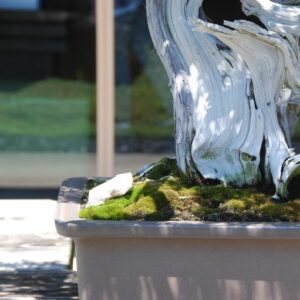
While natural deadwood on a bonsai tree can be created through a natural process of decay, it is also possible to create deadwood artificially. This process involves removing or damaging the bark of a branch or trunk and exposing the underlying tissue of the tree in a controlled manner to create the appearance of deadwood.
One common technique used to create artificial deadwood on a bonsai tree is carving. This involves using tools such as carving knives, chisels and gauges to remove the bark in a way that mimics the natural patterns and textures of deadwood.
Once the carving is complete, put lime sulfur for pest prevention, wrap with (sphagnum) moss or protection tape around the area for a few months and let it heal over time.
It is important to note that the creation of artificial deadwood should be done only on a healthy bonsai tree. When creating “shari” on the trunk, the peeled area naturally dies, which can be a significant stressor for the tree. It may thus be safer to do the process gradually over a period of several years.
Remember that improper technique or carelessness can lead to irreversible damage to the tree, and may even kill it.
Types of Trees Best Suited for Bonsai Deadwood

Uro on plum blossom bonsai
While bonsai deadwood makes an interesting visual appeal, some species are better suited for it than others. The ideal bonsai tree for the deadwood technique is one that saps lots of natural resins and has rough and textured bark.
Resin is a type of tree sap that is produced usually through the bark of a tree as a self-defense and healing mechanism when an injury occurred. It is sticky and hardens when exposed to air. As it can rapidly seal wounds, resinous trees can react well when we intentionally peel off the bark.
The common resinous tree species with rough bark are coniferous trees. Pine, juniper, spruce, cedar, fir, yew, and larch are included in the resinous species that are suitable for bonsai deadwood.
Other suitable bonsai species for the deadwood technique are trees with hard xylem. Examples include plum blossom and Japanese persimmon (“kaki”) but apart from those two, most deciduous trees do not tolerate well when applied bonsai deadwood technique.
Can the Bonsai Deadwood Technique Harm Your Tree?

Shari and Jin
While the deadwood can be visually striking, it is not without risks when applying the deadwood technique intentionally. Improper procedure or carelessness in creating bonsai deadwood can lead to irreversible damage to the tree, and in some cases, may even kill it.
Potential Risks with bonsai deadwood
Damage to the tree
One risk associated with the deadwood technique is the potential for damage to the tree. Deadwood can cause additional damage to living cells from the wound you make, weakening the trees’ ability to absorb water. This may be a very serious problem if the trunk bark is peeled off because the tree may die from not being able to take up water.
This is why bonsai deadwood should only be created artificially on the resinous trees, which are mostly coniferous species. Tree resins seal wounds and help heal them quickly.
The Bonsai deadwood technique should not be applied to most deciduous trees. Although deciduous trees can heal themselves from injuries with tree sap, it does not have the same adhesive properties as resin and may not be as effective in sealing large or deep wounds.
Also, deadwood should be created on healthy trees only. Attempting to create deadwood on the living tissues of an unhealthy tree can harm and potentially kill it.
Introduction of pests and diseases
Another risk associated with the deadwood technique is the introduction of pests and diseases. (Artificial) deadwood is more prone to rot and decay than living tissue, which can attract pests and pathogens.
To minimize this risk, it is important to apply preservatives such as lime sulfur after creating deadwood artificially. Keep the deadwood clean and free from debris, and apply preservatives once a year to prevent rot as well as pests.
If you are not sure of the deadwood technique, it is important to proceed with caution and seek the advice of experienced bonsai growers or professionals if you can. I cannot stress enough that the bonsai deadwood technique has the potential to kill your tree.



